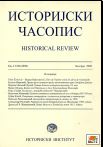Култови светитеља заштитника од куге у Котору (XIV-XVI век)
Cults of the Saints-Protectors from the Plague in Kotor (From the XIV to the XVI Century)
Author(s): Valentina ŽivkovićSubject(s): History
Published by: Istorijski institut, Beograd
Keywords: plague; Kotor; piety; saint-protector; testament; church; relics; fine arts representation
Summary/Abstract: The written sources (judiciary-notarial documents issued by the community of Kotor), the relics of the saints and the preserved religious artefacts allow the possibility of investigating the different aspects of the plague phenomenon, ranging from the ways the disease spread its impact on the quotidian inhabitants’ behaviour, to the changes occurred in the religious practice of the believers. The contents of the testaments are proved to be the sources of the utmost utility for the exploration of this issue due to the fact that they offer the means to comprehend the specific mentality of the inhabitants of Kotor faced with the fear of this disease and their consequently altered piety. The most common pattern of manifesting one’s religious devotion, induced by this fear of morte cruda di peste was to be observed through the addressing to the saints-protectors for help. Saint Sebastian, Saint Rock, Saint Christopher and Saint Vincent Ferrer were venerated in particular as saints-protectors from the plague in Kotor. These cultic solemnities in Kotor have been examined on the grounds of the material provided by the sources and consequently analysed from the viewpoint of the environmental specificities. Saint Christopher was particularly venerated as the protector of travellers, pilgrims and sailors in the busy commercial town of Kotor. After the plague epidemics began spreading, people started to believe that he also had the power to offer protection from this disease. In the mid XIVth century his image was depicted in giant proportions on the front of the Saint Anna’s church. The inhabitants of Kotor put their greatest hopes in the intervention of Saint Sebastian and Saint Rock from the XVth century onwards. The cult of Saint Sebastian was cherished by Stefan Kalođurđević, canzellarius sclavus communitatis Catari, who built the church that bore the saint’s holy name in his garden outside the South citywalls. The image of Saint Sebastian was also depicted in Kalođurđević’ church consecrated to Saint Lady in Mržep dating from 1451. The cult of dominican preacher, Vincent Ferrer, started to flourish in Kotor briefly after his canonization took place in the year of 1455. By the end of the XVth century, a small church just aside the dominican monastery of Saint Nicolas was erected in Kotor and consecrated to the aforementioned saint. The inhabitants’ beliefs concerning St. Vincent’s protection from the plague can be traced in the XVIth century narrative from the life of the Blessed Osanna of Kotor.
Journal: Историјски часопис
- Issue Year: 2009
- Issue No: 58
- Page Range: 181-196
- Page Count: 16
- Language: Serbian

